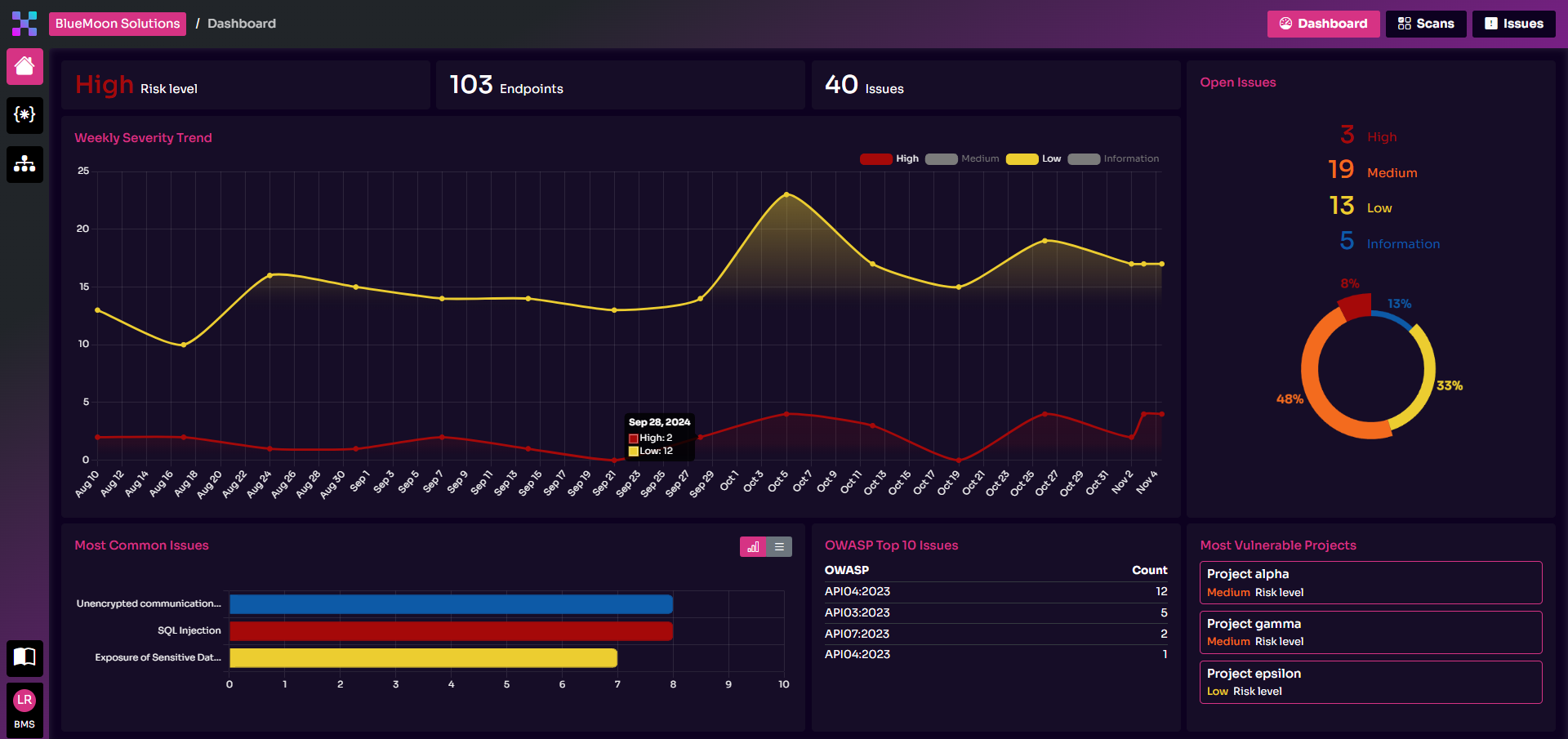Why Manual API Penetration Testing is Costing You a Fortune
Carlo De Micheli, Zoran Gorgiev

With API data breaches up by 80% year-on-year, API calls making up 71% of the overall web traffic, and compliance requirements demanding pen testing, realizing that API penetration testing is indispensable is a straightforward affair. However, this realization is only half of the solution.
The other half is understanding how exactly to put it into practice without paying an arm and a leg.
Manual or automated API pen testing? Which one is more cost-effective? You’ll find the answer in the following sections.
What Determines the Cost of a Manual API Penetration Test?
Three principal factors affect the cost of a penetration test:
1. API Coverage
By coverage, we mean both the number of API endpoints and the number of API sequences.
This factor is two-dimensional, the two dimensions being breadth and depth. The more endpoints you test, the more you go in breadth. The more API sequences you test, the more you go in depth.
A complete or comprehensive penetration test implies maximal possible breadth and depth. That, in turn, means longer and more complex and, hence, more costly testing.
2. Testing Frequency
This factor is more or less self-explanatory. All things being equal, testing once a year or once in a blue moon cannot cost as much as testing and retesting or testing quarterly, let alone continuously.
3. Pen Tester’s Expertise and Reputation
The pen tester’s expertise and reputation influence cost in the most direct way.
Even before they hire pen testers, organizations check their credentials, track record, competence, and skills. Usually, a higher reputation and narrower expertise go hand in hand with higher costs.
When we say narrower expertise, we mean pen testers who specialize in API security testing, not, for example, web application pen testers who can also test APIs. Considering that these specialists are scarce, expect a highly reputable penetration testing company or a skillful API pen tester to cost a king’s ransom.
How Many Pricing Types Are There?
Manual API penetration testing can be performed by in-house pen testers—a team of cybersecurity professionals who do penetration testing as your organization’s employees—or by external individual pen testers or penetration testing companies.
In terms of costs, in-house testing entails regular salaries, bonuses, and other employee benefits.
External testing, on the other hand, includes three basic pricing models:
-
Fixed pricing: You pay a clearly defined sum regardless of the hours of work. The upside is the simplicity of the pricing model. The downside is that the price may not correspond to the complexity, speed, and quality of the pen test. That is, you may be overcharged and realize that too late.
-
Hourly rate: You pay based on the number of hours worked. This model allows you to avoid overcharging. However, the risk is that the API testing can take too long without the goal being effectively accomplished.
-
Credit-based pricing: One credit can include several hours per tester. Usually, the more credits you buy, the higher the chance you get a discount, which can be appealing to many organizations. However, this model is more complex than the previous two and includes the possibility that you pay for more than you need.
External or outsourced API penetration testing is awfully pricey and complex to scale. Hence, you may be forced to restrict its scope or accept suboptimal results to manage costs and make it fit into your allocated budget.
Manual API Penetration Testing: Why Does It Cost So Much?
There are four main reasons why manual API penetration testing costs you a fortune.
1. High Testing Price
The average cost for manual testing can go as high as $25K per API application application. And we’re talking about one-time testing.
However, one-time testing is hardly the standard anymore, and the drink is on us if you find an enterprise using only one API application.
Due to the unprecedented proliferation of APIs, the enormous expansion of the API attack surface, the wild surge in API attacks, and the highly accelerated software development and deployment processes, the new recommendation is regular, frequent penetration testing.
Can you imagine the price for manual API pen testing of tens or even hundreds of APIs multiple times a year?
2. Shift-Left, DevOps, and DevSecOps
The current shift-left, DevOps, and DevSecOps approaches include agile development and quick-paced deployment. As such, they require continuous security testing as part of the CI/CD pipeline.
APIs are also software components, so they, too, change constantly. Once the API test is finished, you receive a report with the findings. However, this report only shows the state of your APIs at a single point in time.
Very soon, this state can change, and in a month, your testing results can become virtually obsolete—irreflective of your API’s actual state. You’ll need a new security assessment with potentially new remediation guidelines. And over and over again.
From this perspective, API pen testing must become a continuous process. However, continuous manual penetration testing is hardly doable. But even if it is, it incurs an immense cost increase.
3. Expertise or the Lack Thereof
The ratio between the demand for and the supply of penetration testers is utterly disproportional. The situation is even worse when API penetration testers are in question.
API pen testing requires a specialized set of skills and hands-on experience that differs from the competencies and expertise of a web application pen tester.
For starters, in contrast to web apps, APIs allow direct interaction beyond the user interface, independent of both client- and server-side controls.
Additionally, as gateways that connect disparate systems and different components in a single system, APIs take a unique role in information environments, whose subtle implications must be clearly understood to guarantee efficient security testing.
On top of this, APIs require an in-depth practical knowledge of standards such as REST, SOAP, GraphQL, JSON-RPC, and OpenAPI.
These factors and more make API penetration testers a rare breed. And what’s scarce and in high demand is always extremely expensive. Take palladium as an example; it’s particularly expensive because it’s particularly rare.
Regardless of whether you outsource API penetration testing or succeed in building a team of experts conducting in-house pen testing, it’s a big and willy-nilly ongoing investment.
4. Time and Coverage
An Equixly’s 2023 study revealed that it takes more than 154 hours, 20 working days, to manually test only 40% of an API with 40 endpoints.
Imagine testing the entire API and generating as many API sequences as possible.
Now, picture a large API application. Going in-depth would take forever and would be challenging to impossible to scale continuously.
Even better, imagine a large enterprise with a stack of APIs, some of which are undocumented or abandoned but not officially retired.
In cybersecurity and business, time is not simply time; it’s cost and waste. In that sense, the manual API penetration testing cost can escalate quickly, especially considering the probability of an API data breach resulting from incomplete API coverage and undocumented vulnerable API endpoints.
Does Automated API Pen Testing Make Things Better?
Yes, it does, and it’s for the following reasons:
- It’s cheaper than manual penetration testing.
- It’s quick and scalable because it’s performed by machines.
- It’s easy to integrate into SDLC (software development life cycle) and CI/CD pipeline.
- It’s suitable for continuous testing since it doesn’t have the overhead costs in both money and time characteristic of manual pen testing.
- It’s consistently efficient, that is, it doesn’t hinge on an individual’s expertise.
- It doesn’t require sophisticated technical skills to be run.
- It’s not affected by skill and labor gaps.
Take Equixly as an example.
Equixly is an API penetration testing tool whose price is a fraction of the cost of manual penetration testing.
Since Equixly relies on machine learning and uses a proprietary AI engine, it understands API sequences and is able to find logic vulnerabilities as well as technical issues like injections. For the very same reason, it can spot traces of new vulnerabilities, zero days, in your environment.
Equixly’s AI engine also allows it to process large volumes of data in hours instead of days and weeks, making it much faster than a human penetrating tester.
Besides, Eqiuxly can find undocumented API endpoints. And because it’s a specialized API security solution— developed by an experienced team that had to tackle API security risk itself and felt all its gravity in practice—it follows the OWASP API Security Top 10 Risks framework when conducting penetration tests.

An automated API penetration testing solution like Equixly is extremely cost-effective, and its ROI is much higher than that of manual penetration testing.
What Does This All Mean?
We’re not arguing that you should dispense with manual API testing. In contrast, in certain cases—say, when you plan to conduct a TLPT (threat-led penetration testing)—it’s necessary.
Our point, instead, is that you can drastically cut costs if you introduce automated API penetration testing in areas where it makes the most sense, such as security testing in the CI/CD, continuous testing, and very frequent testing, as well as testing in environments where professionals are in serious deficit. In other contexts, manual API pen testing makes sense.
Even in those cases where you decide to use both—automated testing regularly and manual testing occasionally—automated testing can cut your costs noticeably.
Reach out to learn details about how Equixly decreases your penetration testing costs and helps you deal with vulnerabilities from development to production.

Carlo De Micheli
Director of Product Marketing
Carlo is a versatile professional with extensive international experience. His enthusiasm for innovation extends across cybersecurity, automotive, and aerospace, where he actively engages in pioneering projects. Holding a technical background in aerospace engineering and supplementing it with independent studies in programming and security, Carlo has organized and presented at international conferences and established tech startups related to the sharing economy and fashion before embracing marketing and sales.

Zoran Gorgiev
Technical Content Specialist
Zoran is a technical content specialist with SEO mastery and practical cybersecurity and web technologies knowledge. He has rich international experience in content and product marketing, helping both small companies and large corporations implement effective content strategies and attain their marketing objectives. He applies his philosophical background to his writing to create intellectually stimulating content. Zoran is an avid learner who believes in continuous learning and never-ending skill polishing.